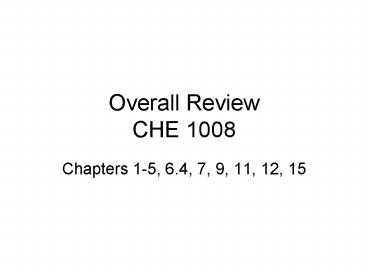Overall Review CHE 1008 - PowerPoint PPT Presentation
1 / 13
Title:
Overall Review CHE 1008
Description:
Closed book, closed notes, I will provide an equation summary sheet ... If you have marked your book carefully this will not be very difficult to do ... – PowerPoint PPT presentation
Number of Views:60
Avg rating:3.0/5.0
Title: Overall Review CHE 1008
1
Overall ReviewCHE 1008
- Chapters 1-5, 6.4, 7, 9, 11, 12, 15
2
Exam Details
- Date, Time, Place Tuesday, 20 April, 2-4 PM,
FMLC - Closed book, closed notes, I will provide an
equation summary sheet - Bring a calculator, ruler, pencils
- Test will include
- Multiple choice
- Short answer
- Calculations (by calculator, not Mathcad or
Aspen) - Test will be comprehensive
3
What Could Be On The Exam?
- Anything in the reading assignments
- Hint Review your reading. If you have marked
your book carefully this will not be very
difficult to do - Anything in the homework---you will not have to
do Mathcad---you will have to know how to solve
the problems - Hint Review all the homework and homework keys,
know how to solve every problem - Anything covered in class lectures
- Hint Review the lecture notes, make sure you
understand the concepts - Anything covered in recitation
4
What Will Not Be On The Exam?
- Aspen or Mathcad problems
- Dialysis problems
- Problems that required very detailed calculations
- Multi-part problems (like the problems on the
previous exams)
5
Concepts Covered
- Chapter 2
- Phase equilibria
- Plotting Txy xy VLE data
- Reading labeling Txy, xy, Ponchon-Savarit
diagrams - Lever arm rule
- Define use K values
- Know how to find dew-points bubble-points
(algorithms)
6
Concepts Covered
- Chapter 3
- Describe the flash distillation process
- Plot the operating line for binary flash on an xy
diagram - Know how to solve sequential and simultaneous
flash problems - Algorithms
- Rachford-Rice energy balances
7
Concepts Covered
- Chapter 4
- Explain how distillation works
- Sketch and label the parts of a distillation
column and know how the parts work - Solve external mass and energy balances
8
Concepts Covered
- Chapter 5
- Write solve mass and energy balances for each
stage in a column - Know when CMO is valid and why it is typically
assumed - Use the operating equations for CMO distillation
- Calculate feed quality
- Find the number of stages and optimal feed stage
using the McCabe-Thiele method
9
Concepts Covered
- Chapter 6
- Know what total reflux is and why it is useful
- Know what minimum reflux is and why it is useful
- Chapter 7
- Know why multicomponent distillation is
trial-and-error - Use assumptions to solve external mass and energy
balances for multicomponent distillation
10
Concepts Covered
- Chapter 9
- Know when the Fenske equation can be used
- Use the Fenske equation to compute Nmin, NF,min,
and splits of non-key components - Use the Underwood equations
- Use the Gilliand correlation
11
Concepts Covered
- Chapter 11
- Describe how simple batch distillation works
- Explain how multistage batch distillation works
- List the differences between batch and continuous
distillation - List advantages and disadvantages of each
- Solve simple batch distillation problems
- Describe how to solve multistage batch
distillation problems
12
Concepts Covered
- Chapter 12
- Describe different types of trays, listing
advantages and disadvantages for each - Discuss the concept of efficiency
- Compute the diameter of sieve and value trays
- Chapter 15
- Compare and contrast adsorption and stripping
operations - Compare and contrast adsorption/stripping with
distillation - Describe how to use the McCabe-Thiele method for
adsorption and stripping - Discuss calculation of the operating lines for
adsorption/stripping
13
Sample Questions
- List the assumptions of constant molal overflow
- Given a value of a, and fractional recovery,
compute Nmin - Compute the top and bottom operating lines (given
sufficient information) - Identify features of Txy and xy phase diagrams
- Use a Ponchon-Savarit diagram to find the
enthalpy and composition of the outlet streams
from a flash drum - Draw operating lines and stages on a xy diagram
to estimate the number of trays in a distillation
column using McCabe-Thiele analysis - You can assume that the mass flow rates of the
liquid and vapor streams are constant in an
absorber problem when - (a) The solute concentrations are lt 10
- (b) Henrys law is valid
- (c) The solute concentrations are 1 or less
- (d) Both (b) and (c)































